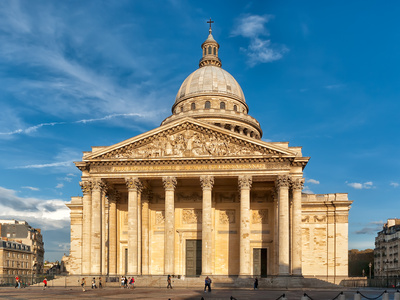Zoom on the Pantheon
 You probably know that the Panthéon is the final resting place for ‘great men’ who epitomised various moments in French history. The crypt is located in Paris’ 5th arrondissement. It is visited by nearly 7 million tourists every year and currently accommodates 72 great men, including Voltaire and Jean-Jacques Rousseau (precursors of the French Revolution), Victor Hugo and Émile Zola (19th-century, politically-active writers), Pierre and Marie Curie, Jean Jaurès, Jean Moulin, André Malraux and many others.
You probably know that the Panthéon is the final resting place for ‘great men’ who epitomised various moments in French history. The crypt is located in Paris’ 5th arrondissement. It is visited by nearly 7 million tourists every year and currently accommodates 72 great men, including Voltaire and Jean-Jacques Rousseau (precursors of the French Revolution), Victor Hugo and Émile Zola (19th-century, politically-active writers), Pierre and Marie Curie, Jean Jaurès, Jean Moulin, André Malraux and many others.
But the Panthéon’s story goes back further than its incarnation as a necropolis: the Panthéon only became a secular site dedicated to the cult of France’s great men at the time of the French Revolution (in 1791, following the death of Mirabeau). Originally, the building was a church (the Eglise St. Geneviève) built by Jacques-Germain Soufflot, which King Louis XV commissioned in 1744 and which was erected between 1764 and 1790.
During the 19th century, the Panthéon’s function wavered between Catholic place of worship and secular temple under Napoleon’s reign. With the death of Victor Hugo in 1885, the French state dedicated the Panthéon to the purpose we know it for today, the celebration of great men.
The Panthéon includes a nave and a crypt, a formation adapted for its original religious function. After the Revolution it underwent modifications to adapt it to its new function as a secular temple: the original religious and monarchic decorations were replaced in order to make it more austere. The references chosen mask the Panthéon’s Gothic side and the decorations installed are based on civic qualities.
Foucault’s pendulum was the first concrete experiment that was able to prove what Copernicus and Galileo had hypothesised: that the Earth moves around the sun. This large pendulum is suspended from a 219-foot steel cable. It was installed in 1851 during a time when the Panthéon was secular, as anticlerical theories went against the thinking of the Catholic Church.
Restoration works have been under way since January 2013 in order to resolve the building’s structural problems. You can visit the nave and the crypt and see a reproduction of Foucault’s pendulum. The monument is open throughout the works, even if access to certain areas is restricted. It is one of the biggest restoration projects in Europe.











Leave a Reply